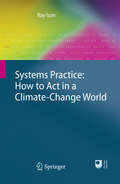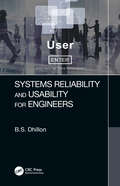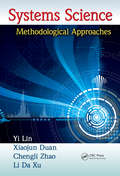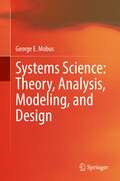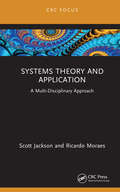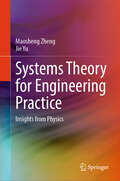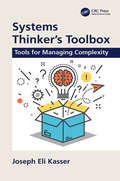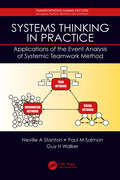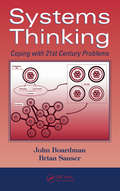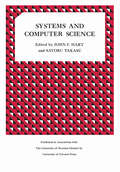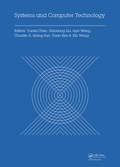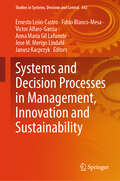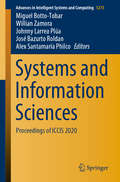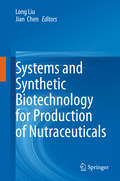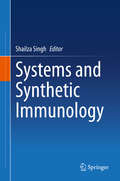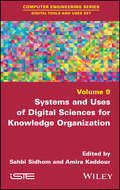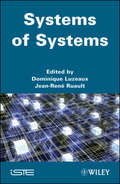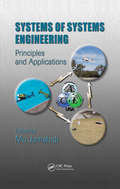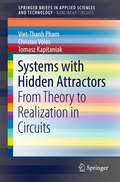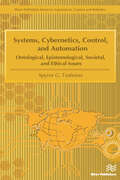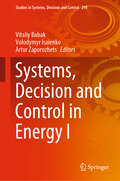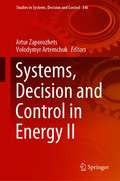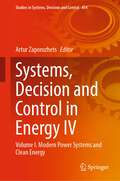- Table View
- List View
Systems Modeling: Methodologies and Tools (EAI/Springer Innovations in Communication and Computing)
by Kishor S. Trivedi Antonio PuliafitoThis book covers ideas, methods, algorithms, and tools for the in-depth study of the performance and reliability of dependable fault-tolerant systems. The chapters identify the current challenges that designers and practitioners must confront to ensure the reliability, availability, and performance of systems, with special focus on their dynamic behaviors and dependencies. Topics include network calculus, workload and scheduling; simulation, sensitivity analysis and applications; queuing networks analysis; clouds, federations and big data; and tools. This collection of recent research exposes system researchers, performance analysts, and practitioners to a spectrum of issues so that they can address these challenges in their work.
Systems Practice: How to Act in a Climate Change World
by Ray IsonIt is now accepted that humans are changing the climate of the Earth and this is the most compelling amongst a long litany of reasons as to why, collectively, we have to change our ways of thinking and acting. Most people now recognise that we have to be capable of adapting quickly as new and uncertain circumstances emerge: this capability will need to exist at personal, group, community, regional, national and international levels, all at the same time. Systems Practice is structured into four parts. Part I introduces the societal need to move towards a more systemic and adaptive governance against the backdrop of human-induced climate change. Part II unpacks what is involved in systems practice by means of a juggler metaphor; examining situations where systems thinking offers useful understanding and opportunities for change. Part III identifies the main factors that constrain the uptake of systems practice and makes the case for innovation in practice by means of systemic inquiry, systemic action research and systemic intervention. The book concludes with Part IV, which critically examines how systems practice is, or might be, utilised at different levels from the personal to the societal. The development of our capabilities to think and act systemically is an urgent priority and Systems Practice aims to show how to do systems thinking and translate that thinking into praxis (theory informed practical action) which will be welcomed by those managing in situations of complexity and uncertainty across all domains of professional and personal concern.
Systems Reliability and Usability for Engineers
by B.S. DhillonEngineering systems are an important element of world economy. Each year billions of dollars are spent to develop, manufacture, operate, and maintain various types of engineering systems about the globe. The reliability and usability of these systems have become important because of their increasing complexity, sophistication, and non-specialist users. Global competition and other factors are forcing manufacturers to produce highly reliable and usable engineering systems. Along with examples and solutions, this book integrates engineering systems reliability and usability into a single volume for those individuals that directly or indirectly are concerned with these areas.
Systems Science: Methodological Approaches (Advances in Systems Science and Engineering (ASSE))
by Yi Lin Xiaojun Duan Chengli Zhao Li Da XuBy making use of the principles of systems science, the scientific community can explain many complicated matters of the world and shed new light on unsettled problems. Each real science has its own particular methodology for not only qualitative but also quantitative analyses, so it is important to understand the organic whole of systems research
Systems Science: Theory, Analysis, Modeling, and Design
by George E. MobusThis book describes a comprehensive approach to applying systems science formally to the deep analysis of a wide variety of complex systems. Detailed ‘how-to’ examples of the three phases (analysis-modeling-design) of systems science are applied to systems of various types (machines, organic (e.g. ecosystem), and supra-organic (e.g. business organizations and government). The complexity of the global system has reached proportions that seriously challenge our abilities to understand the consequences of our use of technology, modification of natural ecosystems, or even how to govern ourselves. For this reason, complex mathematics is eschewed when simpler structures will suffice, allowing the widest possible audience to apply and benefit from the available tools and concepts of systems science in their own work. The book shows, in detail, how to functionally and structurally deconstruct complex systems using a fundamental language of systems. It shows how to capture the discovered details in a structured knowledge base from which abstract models can be derived for simulation. The knowledge base is also shown to be a basis for generating system design specifications for human-built artifacts, or policy recommendations/policy mechanisms for socio-economic-ecological systems management. The book builds on principles and methods found in the authors’ textbook Principles of Systems Science (co-authored with Michael Kalton), but without prerequisites. It will appeal to a broad audience that deals with complex systems every day, from design engineers to economic and ecological systems managers and policymakers.
Systems Theory and Application: A Multi-Disciplinary Approach
by Scott Jackson Ricardo Moraes MoraesThis book describes the characteristics of he five different disciplines of systems which are Systems Theory, Systems Science, Thinking in Systems, Systems Architecting, and Systems Engineering. The book discusses how they all relate to each other and form a synergistic set of disciplines. Systems Theory and Application: A Multi-Disciplinary Approach presents how the five different disciplines of systems are all related to each other. The book offers a concise view of the systems perspective and discusses how it applies to many system types such as physical, abstract, and human. Highlights are on how systems disciplines address problems and abandon the fragmented approach of implementing the disciplines separately. The book forms an enlightenment on understanding the relationship between systems engineering and system theory and explains that systems are everywhere, and that universe is made up of systems. Students, designers, and those interested in systems theory will find this book of interest.
Systems Theory for Engineering Practice: Insights from Physics
by Jie Yu Maosheng ZhengThis book presents cognition of the universality of systems theory thinking by using some ordinary physical phenomena and their methods in study, of which the involved treatments are consistent with the viewpoint of systems theory. It contains the collective actions of classical vibration of many bodies and wave, the extreme value problem in natural world, status of electrons in atom-molecule and metals, Ising model in phase transition and elementary excitation in solid, multi-objective optimization in a system, description of effective media approximation, certainty in uncertain phenomena, all these reflect the cooperative/synergetic effects, wholeness of group actions, “unity of opposites” inside a system, and collective phenomena in a system completely. The relevant methodologies for systems theory are organic combination and synergism of both “reductionism” and “holism” instead of “confrontation” or “separation” of them, which could be used in dealing with analogous problems in systems science and engineering fields in response to the idiom of “stones from other hills being good for polishing this jade” and “comprehend by analogy”, so as to promote the transformation of wisdom to productivity. The authors wish this work could play its role as a paving stone to serve the research and application of systems theory. This book can be used as a textbook for postgraduate and advanced undergraduate students in relevant majors, and a reference book for scientists and practitioners in related fields.
Systems Thinker's Toolbox: Tools for Managing Complexity
by Joseph Eli KasserSystems Thinker's Toolbox: Tools for Managing Complexity provides more than 100 tools based on systems thinking and beyond. Each tool is described, and when necessary, examples are provided of how each of them can be used. Some of the simplest tools can be combined into more complex tools. The tools may be things such as lists, causal loops, and templates, as well as processes and methodologies. Key Features Provides an explanation of the two views of systems thinking; systemic and systematic thinking, and then shows how to perform each of them in a complimentary manner Presents a set of thinking tools that can be used to apply systems thinking to solving problems in project management, engineering, systems engineering, new product development, and business Describes the tools from simple such as lists, and goes on to more complex such as Categorized Requirements in Process (CRIP) charts, and then onto the processes Introduces new tools that have been tested with positive feedback Discusses a set of communication tools that can improve project reviews and communicating innovative ideas
Systems Thinking in Practice: Applications of the Event Analysis of Systemic Teamwork Method (Transportation Human Factors)
by Paul Salmon Neville Stanton Guy WalkerThis book presents the latest developments of Systems Thinking in Practice to the analysis and design of complex sociotechnical systems. The Event Analysis of Systemic Teamwork (EAST) method is applied to micro, meso and macro systems. Written by experts in the field, this text covers a diverse range of domains, including: automation, aviation, energy grid distribution, military command and control, road and rail transportation, sports, and urban planning. Extensions to the EAST method are presented along with future directions for the approach. Illustrates a contemporary review of the status of Distributed Cognition (DCOG) Presents examples of the application of Event Analysis of Systemic Teamwork (EAST) method Presents examples of the application of Event Analysis of Systemic Teamwork (EAST) method Discusses the metrics for the examination of social, task, and information networks Provides comparison of alternative networks with implications for design of DCOG in systems
Systems Thinking: Coping with 21st Century Problems (Systems Innovation Book Series)
by John Boardman Brian SauserBy examining the links and interactions between elements of a system, systems thinking is becoming increasingly relevant when dealing with global challenges, from terrorism to energy to healthcare. Addressing these seemingly intractable systems problems in our society, Systems Thinking: Coping with 21st Century Problems focuses on the inhere
Systems and Computer Science: Proceedings of a Conference held at the University of Western Ontario September 10-11, 1965
by John Hart Satoru TakasuThis book presents the papers delivered at the Conference on Systems and Computer Science held at the University of Western Ontario in September 1965. The primary purposes of the Conference were the promotion of research and the development of the teaching of computer science in Canadian universities. The papers focus attention on some of the concepts of Computer Science as a new field of study and at the same time provide a background for scientists looking at the subject for the first time. The chief developments in computer science have been concerned with the "applied" rather than the "pure" areas of the field: numerical analysis, applied statistics and operations research, and data processing. But there is something more to computers than the physical components and this book represents an attempt to correct the imbalance between "applied" and "pure" by drawing attention to certain theoretical aspects of computer and information science. Among the topics discussed are the theory of finite and infinite automata, aspects of formal language theory, heuristic and non-heuristic approaches to theorem proving and the mathematical formulation of the theory of general systems. There are also references to the problems of machine design, to software systems including higher-level languages, to multiple control computer models and to applied systems. This collection of papers will appeal first to graduate students and professors in Computer Science. It will also be of interest to computer scientists in industry and in government and university research groups and to the scientific public interested in discovering some of the principal ingredients and directions of the computer and information sciences.
Systems and Computer Technology: Proceedings of the 2014 Internaional Symposium on Systems and Computer technology, (ISSCT 2014), Shanghai, China, 15-17 November 2014
by Xin Wang Yuan Ren Lipo Wang Yunfei Chen Xiaodong Liu Chunlei Ji Qiang SunThis volume consists of papers presented at the 2014 International Symposium on Systems and Computer Technology (ISSCT 2014, Shanghai, China, 15-17 November 2014). The demand for systems and informatics have been constantly increasing, as more and more computer applications have been built. Great efforts have been made to improve the state of the a
Systems and Decision Processes in Management, Innovation and Sustainability (Studies in Systems, Decision and Control #562)
by Janusz Kacprzyk Ernesto León-Castro Fabio Blanco-Mesa Victor Alfaro-Garcia Anna Maria Gil Lafuente Jose M. Merigo LindahlThe book presents a series of papers with different methodologies that allow us to visualize how the systems support decision-making in areas such as the tourism sector, entrepreneurship, quality of work life, gender, motivation, circular economy, innovation, law, finance, and bibliometrics. The book also finds a series of cases applied in different countries, where through the information collected and the data analyzed, new improvement processes can be generated at the business level and the local, regional, and national levels within Ibero-America. The book presents new methods and systems to create better decision-making processes in the changing and uncertain environments in which people, companies, and governments interact.
Systems and Information Sciences: Proceedings of ICCIS 2020 (Advances in Intelligent Systems and Computing #1273)
by Miguel Botto-Tobar Willian Zamora Johnny Larrea Plúa José Bazurto Roldan Alex Santamaría PhilcoThis book constitutes the proceedings of the 1st International Conference on Systems and Information Sciences (ICCIS), held in Manta, Ecuador, from July 27 to 29, 2020, and was jointly organized by Universidad Laica Eloy Alfaro de Manabí “ULEAM”, in collaboration with GDEON. ICCIS aims to bring together systems and information sciences researchers and developers from academia and industry around the world to discuss cutting-edge research. The book covers the following topics:AI, Expert Systems and Big Data AnalyticsCloud, IoT and Distributed ComputingCommunicationsDatabase System and ApplicationFinancial Technologies (FinTech), Economics and Business Engineeringm-Learning and e-LearningSecuritySoftware EngineeringWeb Information Systems and ApplicationsGeneral Track
Systems and Synthetic Biotechnology for Production of Nutraceuticals
by Jian Chen Long LiuThis book discusses systems and synthetic biotechnologies for the production of nutraceuticals, and summarizes recent advances in nutraceutical research in terms of the physiological effects on health, potential applications, drawbacks of traditional production processes, characteristics of production strains, and advances in microbial production based on systems and synthetic biotechnology. It also examines future directions in the microbial production of nutraceuticals using systems and synthetic biology. The book is intended for researchers and graduate students in the field of molecular biology and industrial biotechnology as well as staff working in the nutraceutical industry.
Systems and Synthetic Immunology
by Shailza SinghSystems and Synthetic Immunology focuses on the similarities between biology and engineering at the systems level, which are important for applying engineering theories to biology problems. With the advent of new genomic techniques, there are numerous systematic investigations underway in the scientific world. This volume highlights techniques that can be used to effectively combine two of the most essential biological fields - Systems Biology and Synthetic Immunology.The respective chapters discuss the role of synthetic immunology in biotechnology, production of biomaterials, and their use in vaccine delivery. Further topics include the importance of cytokines; the use of genomic engineering tools in immunotherapy; immunosensors; nanotherapeutics; and bioinformatics tools in biomedical applications. Given its scope, the book offers readers an up-to-date and comprehensive review of this unique and dynamic field of research.
Systems and Uses of Digital Sciences for Knowledge Organization
by Sahbi Sidhom Amira KaddourSystems and Uses of Digital Sciences for Knowledge Organization is a large-scale scientific work that brings together researchers and R&D professionals to discuss ideas and actions in the organization of knowledge. The main objective of this book is to define collaborative strategies, use advanced technologies in multiple research fields and outline applications of knowledge organization and its cultural, education, economic and industrial potential.The organization of knowledge and advanced technologies (OCTA) asks the following questions: How can we strengthen alliances between multi-disciplinary and trans-disciplinary studies? How can we broaden our skills surrounding common objects of study? How can we innovate the solutions found and propose sustainable development to society confidently? This book is a result of intensive and collaborative work between highly respected scientific authors. The nine chapters that have been selected for this book have been peer-reviewed by the OCTA program committee, both as written submissions and when presented during the OCTA multi-conference on organization.
Systems of Systems (Wiley-iste Ser.)
by Jean-René Ruault Dominique LuzeauxIn recent years, the systems designed to support activity in the fields of banking, health, transportation, space, aeronautics, defense, etc. have become increasingly larger and more complex. With the growing maturity of information and communication technologies, systems have been interconnected within growing networks, yielding new capabilities and services through the combination of system functionalities. This has led to a further increasing complexity that has to be managed in order to take advantage of these system integrations. The book is divided into two parts. The first part addresses the concept and practical illustrations of a “system of systems” and is a multidisciplinary introduction to the notion of a “systems of systems” that is discussed extensively in the current scientific and technical literature. After a critical comparison of the different definitions and a range of various practical illustrations, this part provides answers to key questions such as what a system of systems is and how its complexity can be mastered. The second part, described as “systems-of-systems engineering: methods and tools”, focuses on both engineering and modeling, and standardization issues that are critical to deal with the key steps in systems of systems engineering: namely eliciting stakeholder needs, architecture optimization, integration of constituent systems, qualification, and utilization.
Systems of Systems Engineering: Principles and Applications
by Mo JamshidiAs technology presses forward, scientific projects are becoming increasingly complex. The international space station, for example, includes over 100 major components, carried aloft during 88 spaces flights which were organized by over 16 nations. The need for improved system integration between the elements of an overall larger technological system has sparked further development of systems of systems (SoS) as a solution for achieving interoperability and superior coordination between heterogeneous systems. Systems of Systems Engineering: Principles and Applications provides engineers with a definitive reference on this newly emerging technology, which is being embraced by such engineering giants as Boeing, Lockheed Martin, and Raytheon. The book covers the complete range of fundamental SoS topics, including modeling, simulation, architecture, control, communication, optimization, and applications. Containing the contributions of pioneers at the forefront of SoS development, the book also offers insight into applications in national security, transportation, energy, and defense as well as healthcare, the service industry, and information technology. System of systems (SoS) is still a relatively new concept, and in time numerous problems and open-ended issues must be addressed to realize its great potential. THis book offers a first look at this rapidly developing technology so that engineers are better equipped to face such challenges.
Systems with Hidden Attractors
by Christos Volos Viet-Thanh Pham Tomasz KapitaniakThis brief provides a general overview of nonlinear systems that exhibit hidden-attractor behavior, a topic of interest in subjects as divers as physics, mechanics, electronics and secure communications. The brief is intended for readers who want to understand the concepts of the hidden attractor and hidden-attractor systems and to implement such systems experimentally using common electronic components. Emergent topics in circuit implementation of systems with hidden attractors are included. The brief serves as an up-to-date reference on an important research topic for undergraduate/graduate students, laboratory researchers and lecturers in various areas of engineering and physics.
Systems, Cybernetics, Control, and Automation
by Spyros G. TzafestasSystems, cybernetics, control, and automation (SCCA)are four interrelated and overlapping scientific and technological fields that have contributed substantially to the development, growth, and progress of human society. A large number of models, methods, and tools were developed that assure high efficiency of SCCA applied to practical situations. The real-life applications of SCCA encompass a wide range of man-made or biological systems, including transportations, power generation, chemical industry, robotics, manufacturing, cybernetics organisms (cyborgs), aviation, economic systems, enterprise, systems, medical/health systems, environmental applications, and so on. The SCCA fields exhibit strong influences on society and rise, during their use and application, many ethical concerns and dilemmas. This book provides a consolidated and concise overview of SCCA, in a single volume for the first time, focusing on ontological, epistemological, social impact, ethical, and general philosophical issues. It is appropriate for use in engineering courses as a convenient tutorial source providing fundamental conceptual and educational material on these issues, or for independent reading by students and scientists.Included in the book is:• Background material on philosophy and systems theory• Major ontological, epistemological, societal and ethical/philosophical aspects of the four fields that are considered in the book• Over 400 references and a list of 130 additional books in the relevant fields • Over 100 colored photos and 70 line figures that illustrate the text
Systems, Decision and Control in Energy I (Studies in Systems, Decision and Control #298)
by Vitaliy Babak Volodymyr Isaienko Artur ZaporozhetsThis book examines the problems in the field of energy and related areas (including chemistry, transport, aerospace, construction, metallurgy and engineering) that Ukrainian scientists are currently investigating. The research presented focuses on ensuring the operational reliability, durability and safety of energy equipment, as well as the development of control, diagnostics and monitoring systems in the energy sector. Further, the book explores the ecological consequences of energy facilities , particularly environmental pollution in large cities and industrial areas. Written mainly by representatives of the Council of Young Scientists of the Department of Physical and Technical Problems of Energy at the NAS of Ukraine, it is intended for researchers and engineers, as well as lecturers and postgraduates at higher education institutions interested in the control, diagnosis and monitoring of energy facilities.
Systems, Decision and Control in Energy II (Studies in Systems, Decision and Control #346)
by Artur Zaporozhets Volodymyr ArtemchukThis book examines the problems in the field of energy and related fields (chemical, transport, aerospace, construction, metallurgy, engineering, etc.) and consists of 4 subsections: Electrical Engineering, Heat Power Engineering, Cybersecurity and Computer Science & Environmental Safety. In the first section, authors pay attention to contemporary issues related to the development of the electric power industry, electrical engineering, the physics of electrical phenomena and renewable energy sources (such as solar energy and wind energy). The second section is devoted to modern problems in heat power engineering and considers modern means and methods that increase the efficiency and reliability of the functioning of heat power facilities. The third section is devoted to issues of cybersecurity of critical facilities, in particular energy facilities, as well as the development of computer science and the introduction of modern information and measurement systems in the energy sector. The fourth subsection deals with the problems of rational use of natural resources, accounting for emissions of harmful substances, environmental issues at energy facilities, as well as the development of a methodology for environmental safety. The book includes 21 chapters. A book is for researchers, engineers, as well as lecturers and postgraduates of higher education institutions dealing with issues of control, diagnosis and monitoring of energy facilities.
Systems, Decision and Control in Energy III (Studies in Systems, Decision and Control #399)
by Artur ZaporozhetsThis book describes new energy saving methods and technologies for heat power engineering. The book is devoted to topical issues of energy and related industries. Leading Ukrainian scientists from both scientific institutes and educational universities took part in its creation. The research results are presented in 6 parts: electrical engineering, heat power engineering, nuclear power engineering, fossil fuels, cybersecurity and computer science, environmental safety. Results of regulating of operating modes and applicability of model checking technique in power systems are showed. Separate block of questions regarding the functioning of nuclear power plants, their waste and preventive measures of protection against negative effects on living organisms (including, for example, the Chernobyl nuclear power plant) is considered. The results of the peculiarities of the extraction, purification and use of fossil fuels are presented. In some chapters, presented the results on improving the cybersecurity of energy systems and its resilience to various threats, including the use of 5G technology. Traditionally for this series, issues of ecological safety, the impact of different energy systems on the environment and its protection are considered. A book is for researchers, engineers, as well as lecturers and postgraduates of higher education institutions dealing with energy sector, power systems, ecological safety, etc.
Systems, Decision and Control in Energy IV: Volume I. Modern Power Systems and Clean Energy (Studies in Systems, Decision and Control #454)
by Artur ZaporozhetsThe concept of "energy" includes methods for obtaining and using various types of energy for the needs of human society. Energy is one of the foundations for the development of modern society. The effectiveness of solving social, economic and technical problems, as well as the anthropogenic transformations of nature, is largely determined by energy production and the scale of energy production.Modern energy is not a separate industry, but it penetrates widely into other areas, in particular, chemical, transport, aerospace, construction, metallurgy, engineering, agriculture, etc. The energy sector is based on complex technical systems that are multicomponent, spatially distributed systems that during their operation are affected to a wide range of design and non-design thermomechanical loading conditions, the effects of aggressive fields and units, unauthorized influences (operator errors, terrorism, sabotage) and can reach various limit states.Complex technical systems are characterized by complex non-linear interactions between their constituent elements, complex chains (scenarios) of cause-effect relationships between hazardous, probabilistic events and processes that occur during their life. These scenarios can be implemented over complex ramified scenario trees.Ensuring the operational reliability, durability and safety of power equipment is a difficult task, which is associated with the organization of the reliability of control over the operation of power plants and ensuring optimal conditions for their operation. In this regard, we can distinguish a whole class of tasks related to the development of control systems, diagnostics and monitoring in the energy industry, which are presented in this book. Of particular relevance now is the use of UAVs in the energy sector.Particular attention must be paid to the environmental consequences of the operation of energy facilities, the main of which is significant environmental pollution in large cities and industrial areas.The development of environmental management information systems is the prerogative of the state, corporations and one of the main directions of the national informatization policy. A clearly debugged system of environmental monitoring gives a general idea of the features of the current ecological state, the main directions of state policy in the field of environmental protection, the use of natural resources and environmental safety. The methodology and hardware-software tools for monitoring the state of the environment presented in the monograph are effective tools for supporting decision-making in managing the environmental safety of the atmosphere during its technogenic pollution.

